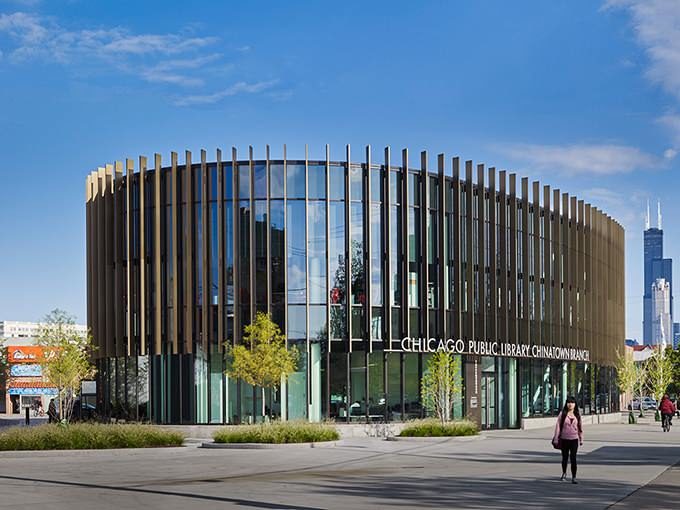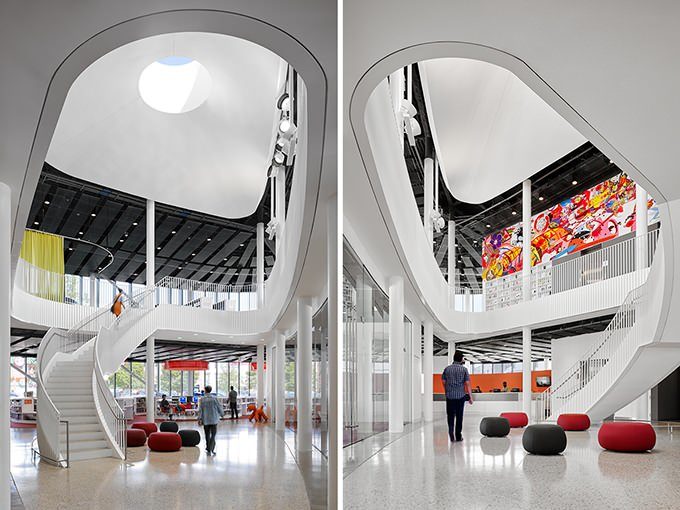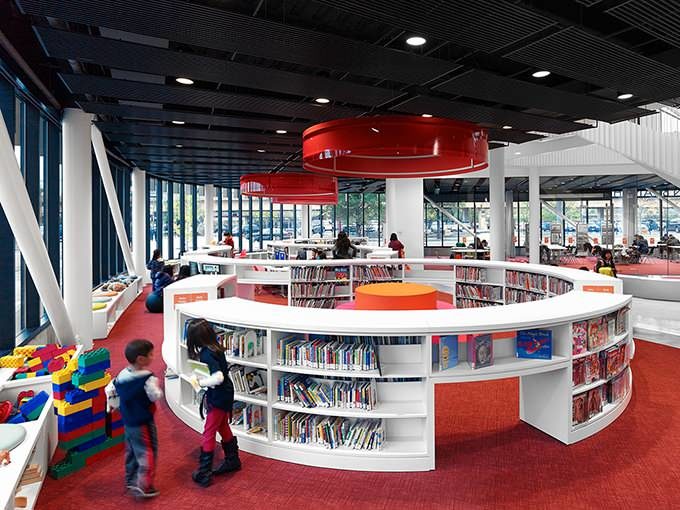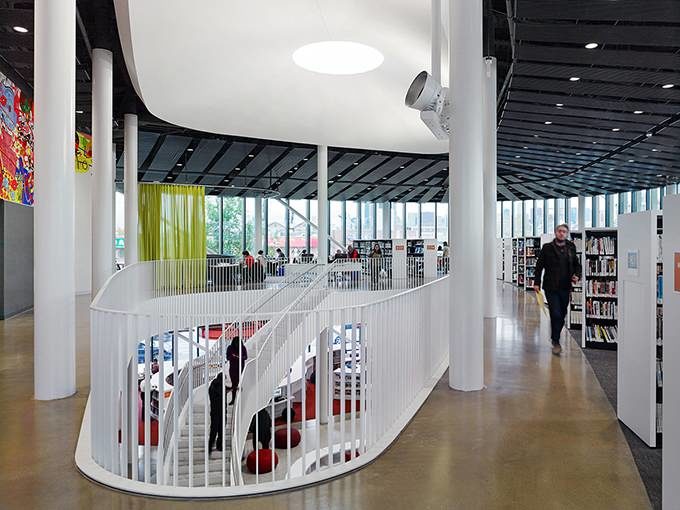



Chicago: Skidmore, Owings & Merrill, LLP (SOM), in conjunction with the Chicago Public Library (CPL), the Public Building Commission of Chicago (PBC), and Wight & Company, is thrilled to announce the opening of the new Chinatown Branch Library, located in Chicago’s Near South Side. The PBC and CPL jointly selected the Design Build team of SOM and Wight & Co. to design and construct the new 16,000-square-foot library. The building creates a new civic, educational, and social hub for Chinatown, providing a much-needed public branch library geared toward inclusive community activities and driven by technology-based learning.
Prior to engaging the design team, the PBC hosted a visioning session for a committee of community stakeholders, librarians, and other stakeholders to envision the goals of the Chinatown branch. As the former Chinatown library was one of the most visited of the 80 locations that make up the CPL system, it was of utmost importance that the community contribute to the design visioning process. The results of the visioning session communicated that today’s urban branch library is not a place solely visited for the purpose of accessing encyclopedic knowledge. Instead, it acts as a community anchor where citizens can connect with global resources and ideas.
The branch’s site-specific design solidifies this role. The building sits at the key intersection of South Archer Avenue and South Wentworth Avenue—the nexus of Chicago’s historic southern and emerging northern Chinatown neighborhoods—and is adjacent to the Cermak-Chinatown CTA Red Line train stop. The soft curves of the pebble shaped, three-sided structure respond to ancient Feng Shui principles by matching the avenues’ existing alignment without creating sharp, aggressive corners. This form allows a fluid movement of pedestrians, abundant landscaping throughout the site, and opens up view corridors so that the building can be seen on all sides.
Inside, the two-story library maximizes CPL required program areas while minimizing the total area. Highly efficient, it is designed for both present and future flexibility. The design team worked closely with CPL officials to identify opportunities for programmatic overlap, thereby increasing the long-term utility. Like a traditional Chinese courtyard plan, all spaces connect to the central atrium room, providing clear orientation and spatial cohesion.
Throughout the library, a spatially interconnected sequence allows for a sense of discovery and exploration. There are very few enclosed spaces to ensure maximum flexibility—the open plan can accommodate multiple uses and furniture or fixture arrangements over time. The children’s zone, exhibition space, central circulation hall, and a community meeting area occupy the ground level. Low shelving arcing through the children’s zone creates interactive and fun spaces for toddlers and caretakers. The placement of the community space allows it to be a flexible, multipurpose room at the center of the library, capable of being used for lectures, tutoring, quiet reading, lounge space, and special events. Acoustical curtains can divide the room into smaller areas, and it has a double-door pantry that supports tea service. Because it is walled in glass, the community area is fully visible to the street, allowing library patrons to see out and outside passersby to see inside as day-to-day activities take place.
A double-height hall and grand stair link the ground level to teen YOUmedia and adult reading rooms above. Eye-height bookshelves in these areas create a sense of openness while still allowing for the creation of informal collaborative areas and intimate reading spots. A brightly colored acoustical curtain defines the teen YOUmedia zone. The spaces also include a multimedia storytelling area and are furnished with elementary school and teen homework and gaming tables.
An 8-foot-high by 60-foot-long mixed-media mural by C.J. Hungerman, titled “Universal Transverse Immigration Proclamation,” was painted on the second-level wall as part of Chicago’s public art program. The artist engaged the community in workshops to understand the history of Chinatown and generations of personal experiences, and then distilled these memories and observations into the content of the work, capturing Chinatown’s personality via marker and paint.
Sustainability also plays a central role in the building’s design—it is on track to achieve LEED® Gold. Its numerous sustainable features include:
- A solar shading screen that is integrated into the building’s glass curtain wall. This screen reduces heat gain on the high performance double glazing without compromising views out to the neighborhood and reduces glare into the space.
- A high degree of facade light transmission and transparency to fill the building with soft daylighting, reducing artificial lighting loads, and creating a visually open and welcoming atmosphere.
- A shaped green roof with native grasses that is visible from the CTA station.
- Permeable paving with a high infiltration rate that reduces the rate and quantity of stormwater runoff.
- Low-energy LED lighting throughout the facility.
- Comprehensive passive features, including the placement of the building core to the west so as to further reduce solar gain and glare.
- Radiant cooling and heating that will improve the building’s energy efficiency, acoustics, and library patron health and comfort. The radiant system also enables the glass curtain wall to achieve maximum transparency without compromising the building’s performance.
The building will serve as a critical piece of architecture within the Chinatown neighborhood. “The Chinatown Branch recognizes the critical role that the library plays in uniting the Chinatown community. It creates a key community anchor and an enduring cultural asset that will serve community members of all ages and accommodate diverse activities,” says Brian Lee, SOM Design Partner. “We hope the building creates a memorable architectural statement that embodies 21st century Chinatown. We are incredibly proud of its design and its position as a library of the future in Chicago’s urban fabric.”
About Skidmore, Owings & Merrill LLP
Skidmore, Owings & Merrill LLP (SOM) is one of the leading architecture, interior design, engineering, and urban planning firms in the world, with an almost 80-year reputation for design excellence and a portfolio that includes some of the most important architectural accomplishments of the 20th and 21st centuries. Since its inception, SOM has been a leader in the research and development of specialized technologies, new processes and innovative ideas, many of which have had a palpable and lasting impact on the design profession and the physical environment. The firm’s longstanding leadership in design and building technology has been honored with more than 1,700 awards for quality, innovation, and management. The American Institute of Architects has recognized SOM twice with its highest honor, the Architecture Firm Award—in 1962 and again in 1996. The firm maintains offices in New York, Chicago, San Francisco, Los Angeles, Washington, D.C., London, Hong Kong, Shanghai, Mumbai, and Abu Dhabi
About Wight & Company
Established in 1939, Wight & Company is a leading Design & Delivery firm based in Chicago. With a professional staff of specialists, including 60 LEED® Accredited Professionals, Wight & Company effectively connects its architecture, engineering and construction services to provide clients in the public and private sectors comprehensive solutions. As the first firm to receive Green Firm Certification from the Sustainable Performance Institute (SPI) and the architect of more than 40 LEED® certified or registered projects including silver, gold and platinum designations, Wight & Company is committed to sustainable design and construction principles. For more information, visit www.wightco.com.
About the Public Building Commission
The Public Building Commission of Chicago manages construction and renovation projects for the City of Chicago and its sister agencies. Mayor Rahm Emanuel serves as the PBC’s chairman. Felicia S. Davis serves as the Executive Director of the PBC. Additional information about the PBC and its projects can be found at www.pbcchicago.com. You can also follow the Public Building Commission of Chicago on Twitter and on Facebook.
About Chicago Public Library
Since 1873, the Chicago Public Library has encouraged lifelong learning by welcoming all people and offering equal access to information, entertainment and knowledge through innovative services and programs, as well as cutting-edge technology. Through its 80 locations, the Library provides free access to a rich collection of materials, both physical and digital, and presents the highest quality author discussions, exhibits and programs for children, teens and adults. CPL was recently selected as the first public library system in the nation to win a National Summer Learning Association award, becoming the inaugural winner of NSLA’s Founder’s Award; received the Social Innovator Award from Chicago Innovation Awards; won a National Medal for Library Services from the Institute for Museum and Library Services and was ranked number one in the U.S. and third in the world by an international study of major urban libraries conducted by the Heinrich Heine University Dusseldorf in Germany.